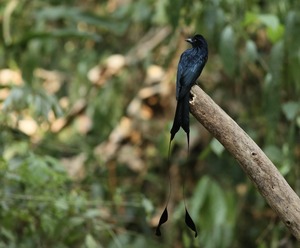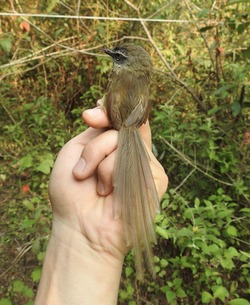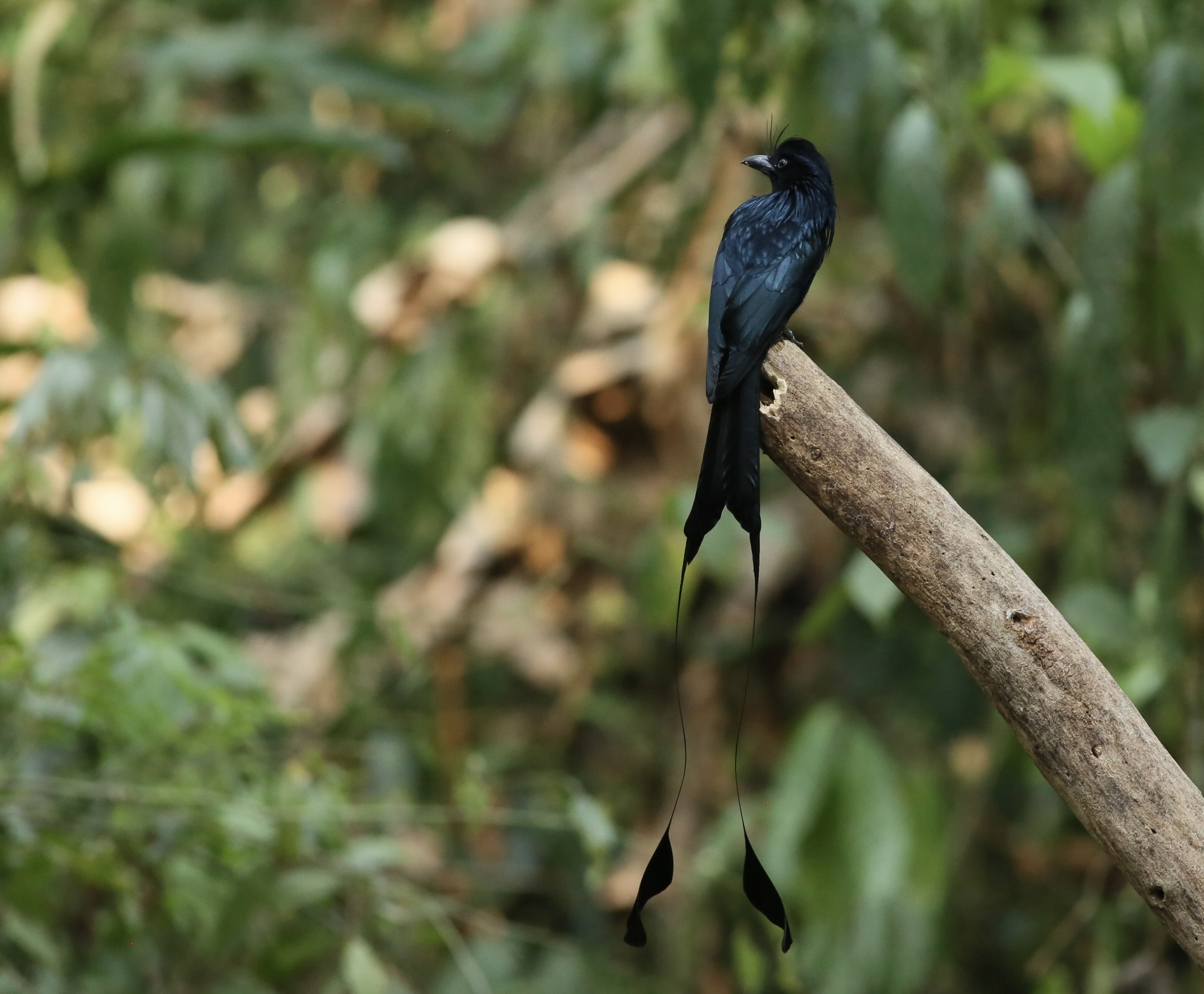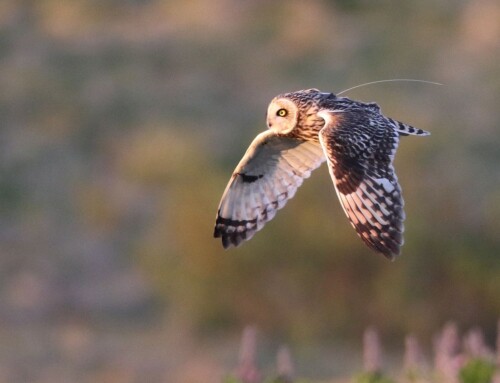 LINKED PAPER
LINKED PAPER
Functions of avian elongated tails, with suggestions for future studies. Zhou, W., Kimball, R. T., Liu, Y., & Robinson, S. K. 2023 Ibis. doi: 10.1111/ibi.13222 VIEW
When birding in Tongbiguan Nature Reserve in south-west China for the first time in 2019, I came across a large and noisy bird with its outer tail feathers greatly lengthened and decorated with two rackets. The bird was a Greater Racket-tailed Drongo (Dicrurus paradiseus, Featured Image). Such an elaborate tail instantly grabbed my interest and made me wonder why some birds possess absurdly long tails. During the COVID-19 pandemic, my colleagues and I spent some time delving into the literature and putting together a review paper about the adaptive functions of avian elongated tails.
Like the Greater Racket-tailed Drongo, many other birds possess elongated tails. These tails can take on many forms, but pintails, forks, and graduated tails are the most common ones (Balmford et al. 1993). Because of the aerodynamic costs, most researchers have attributed the presence of elongated tails to sexual selection (Andersson 1982), especially sexual selection by female choice (Figure 1). In the recent three decades or so, however, new studies have suggested three potential alternatives.

Figure 1 The tail of a male Reeve’s Pheasant (Syrmaticus reevesii) is most likely a result of sexual section © Philip He.
One alternative function is aerodynamic enhancement. Most research on this function has focused on fork-tailed birds. Compared to other tail shapes, a fork-shaped tail has the highest lift-to-drag ratio because it minimizes the amount of drag-incurring area. Therefore, a moderately-forked tail is often considered aerodynamically optimal (Balmford et al. 1993). Additionally, while further elongation of the outer tail feathers (“fork deepening”) increases the amount of drag, it also generates additional lift during turning flight. In a real-life example, the fork-shaped tail of the Swallow-tailed Kite (Elanoides forticatus, Figure 2) is most likely designed for aerodynamic performance.
Another alternative function is anti-predation signaling. The model species for this potential function is the Turquoise-browed Motmot (Eumomota superciliosa). Many species of motmots regularly perform a pendulous movement with their long racket-shaped tails. Through predator-simulation experiments, Murphy (2006) showed that Turquoise-browed Motmots wag their tails to send pursuit-deterrent signals to predators. In other words, by tail-wagging, motmots communicate to their predators the following message: you have been detected. Don’t think about attacking me because I am well-prepared to escape. Murphy’s experiments effectively demonstrated how tail movement by motmots sends an anti-predation signal. However, they failed to explain whether tail elongation itself, not tail movement, intensifies this effect. In other words, it remains unknown whether anti-predation signaling can explain the presence of elongated tails.

Figure 2 The moderately-forked tail of the Swallow-tailed Kite (Elanoides forticatus) is ideal for aerodynamic performance © Mitch Walters.
The last alternative function is perch balancing. While it seems obvious that tails may help birds with their balance, we currently have almost no knowledge about whether tail elongation enhances birds’ balance. The only study that attempted to reveal a balancing role of elongated tails took place in an outdoor aviary with a simulated reed environment. By experimentally manipulating the tail length of Bearded Reedlings (Panurus biarmicus), Pujante et al. (2005) observed differences in their foraging postures. However, without knowing these birds’ foraging efficiency, it is difficult to conclude that elongated tails are selected for perch balancing and potentially increase fitness. Besides the reedlings, some indirect support for the perch balancing function comes from the prinias. Like the reedlings, prinias forage in unstable substrates (e.g., grass). Interestingly, prinias’ tails are significantly longer in the non-breeding season (Figure 4), which is opposite to predictions of the sexual selection hypothesis. To the prinias, perhaps long, balance-providing tails help them forage more efficiently during a harsh winter when resources are most scarce.

Figure 3 The long, graduated tail of the Hill Prinia (Prinia superciliosa) may be important for balancing in unstable substrates © Wenyi Zhou.
Apart from reviewing sexual selection and the three alternative functions, our review also points out directions for future studies. First, we suggest using meta-analyses to explore the relationship between different shapes of elongated tails and different ecological traits on a large scale. For example, as most graduated tails are costly to produce and harmful to birds’ aerodynamics, they are most likely developed for sexual selection reasons. Thus, ecological traits such as sexual dimorphism may be strongly correlated with the presence of gradated tails. In contrast, perhaps a fork-shaped tail is more likely to develop in migratory species and aerial foragers, which rely on aerodynamic maneuvers and lift generation. Second, our study suggests that future studies should be aware that the development of elongated tails may result from multiple forces. For example, in Barn Swallows (Hirundo rustica) the fork-shaped tails are known to be both sexually and aerodynamically selected (Rowe et al. 2001). Therefore, it is important that future studies consider testing alternative hypotheses that are not always mutually exclusive. Third, our study suggests that some adaptive functions of elongated tails may not have been discovered. These include helping birds 1) escape through caudal autotomy, 2) flush prey, and 3) signal other flock mates. A more comprehensive understanding on the topic of avian elongated tails will require more future studies.
Still, we don’t know the adaptive function of the beautiful tail of the Greater Racket-tailed Drongo. However, we hope our study reignites the interest in avian elongated tails because there are still many unknowns waiting for us to discover.
References
Andersson, M. 1982. Female choice selects for extreme tail length in a widowbird. Nature 299:818-820. VIEW
Balmford, A., Thomas, A. L., & Jones, I. L. 1993. Aerodynamics and the evolution of long tails in birds. Nature 361:628-631. VIEW
Murphy, T. G. 2006. Predator-elicited visual signal: why the turquoise-browed motmot wag-displays its racketed tail. Behavioral Ecology 17:547-553. VIEW
Romero-Pujante, M., Hoi, H. & Blomqvist, D. 2005. The importance of tail length for habitat use in the Bearded Tit Panurus biarmicus: an experimental study. Ibis 147:464-470. VIEW
Rowe, L. V., Evans, M. R., & Buchanan, K. L. 2001. The function and evolution of the tail streamer in hirundines. Behavioral Ecology 12:157-163. VIEW
Image credit
Top right: A Greater Racket-tailed Drongo (Dicrurus paradiseus). This species has two elongated outer tail feathers tipped with rackets © Liping Zhou.
If you want to write about your research in #theBOUblog, then please see here.




